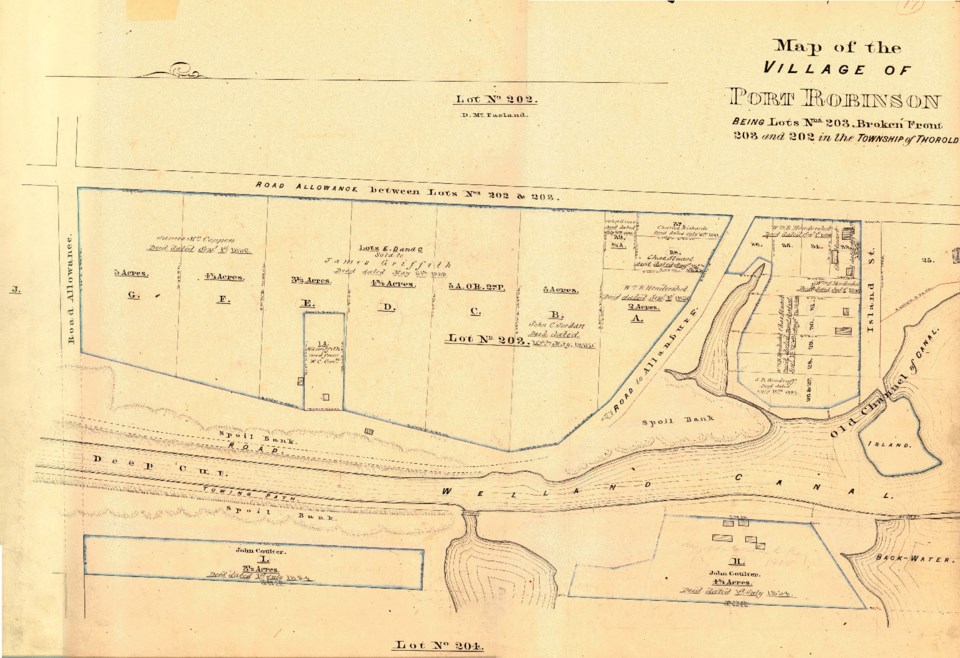In 1879, W. T. Fish was appointed Police Magistrate.
In 1880, the citizens were particularly active in trying to induce capitalists to establish factories here.
The town once possessed the following industries, which no longer exist: four grist mills, a casket factory, a tannery, a plough factory, a sawmill, silver-plating works, a pulp mill, a cotton factory, a shipyard, two potteries, two furniture factories, a wagon factory, a soap factory, a candle factory, a chair factory, a casket hardware factory, felt-works, and several cooperages.
In 1897, the existing industries in Thorold were: two grist mills, a casket factory, a pulp mill, a bicycle factory, a basket factory, a cement mill, a carriage factory, a knitting mill, and a foundry and machine shop. The Quebec Bank had a branch at Thorold, and the Bank of Commerce removed its agency from the town in 1897.
There are five churches in the town: The Methodist, Anglican, Presbyterian, Roman Catholic, and Baptist, the first four being handsome stone buildings. Other good public buildings are the Odd Fellows’ Hall and the Masonic Hall, while many of the residences are both handsome and substantial.
Not all of Thorold’s prominent citizens have been connected with the public life of the town, for in many cases, large business interests have claimed all their time and energies. Among those of whom mention must be made in this connection are: the late Dr. Rolls, the late John Battle, manufacturer and vessel-owner, and John D. McDonald, contractor, also deceased.
Until 1824, Port Robinson was a dense wood, known as the hickory bush; and the only house within the limits of the village was that built on the banks of the Chippawa Creek by the U.E. Loyalist, John Carl. Carl’s nearest neighbour was Peter Misener, whose second house stood about a mile and a half northeast of the village. For many years after white settlers came, the Chippawa Indians lived in wigwams on both sides of the river to which they had given their name; and it was only when they began to be annoyed and ill-treated by the navies working on the canal, that the whole settlement withdrew to the Six Nations Reserve on the banks of the Grand River.
When the excavations began on the old Welland Canal, in 1824, the majority of the men were employed upon the Deep Cut, which lies between Allanburg and Port Robinson; and naturally, a little settlement was made at each terminus of this branch of the work.
John Coulter, who had come from Ireland to take a sub-contract at the southern end of the cut, built the second house in Port Robinson, while Duncan McFarland, who owned a general store near Allanburg, soon afterwards removed to this place. In the same year, the first church was erected by the Presbyterians.
The history of Port Robinson has been largely the history of the canal. With the exception of the Carls, Miseners, Blakes, Lemons and McFarlands, the early inhabitants were Irish, attracted here by the work of excavation. When navigation was opened in 1829, the village became a port of entry, and was called Port Beverly, after Chief Justice Beverly Robinson, who was a member of the Canal Company. In the same way, Merritton, and Merrittsville (now Welland) were called after the chief promoter of the canal scheme. Later on, the name Port Beverly was changed to Port Robinson. A post office was established in the village in 1829, and Duncan McFarland was appointed first postmaster.
In 1832 and 1834, Port Robinson suffered from cholera, as did all the settlements of Irish immigrants along the canal.
All the important boats that used the new waterway, from whichever port they came, were obliged to pass through Port Robinson; and soon it became the most flourishing village in the district. In the matter of trade, it far outrivalled St. Catharines and Buffalo; and Welland County was not yet in existence.
There was a large hotel in the place, owned by Dilly Coleman, and capable of accommodating 100 guests; and in exchange for this he was offered a valuable lot in Buffalo, but of course he refused the offer, as the United States port, which later boasted 300,000 inhabitants, gave no promise at that time of becoming so prosperous a place as the little Canadian village.



